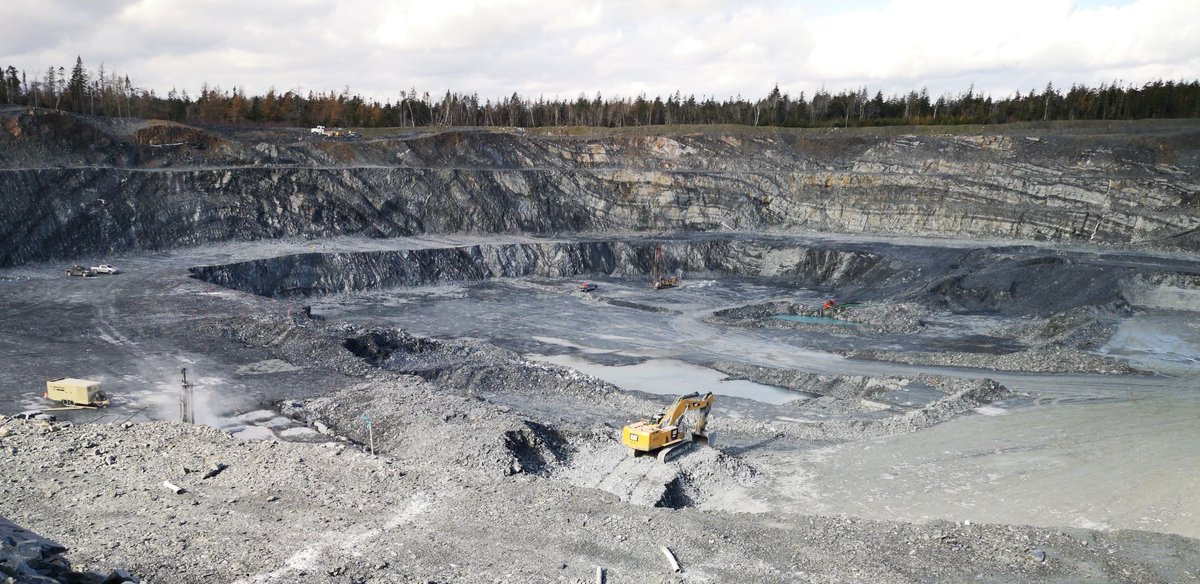We love getting questions about #mining, #minerals and #geology! We were asked about mining in Gays River:
#nspoli #cbpoli #novascotia #capebreton #nshistory @SeanFraserMP @LarryHarrisonPC #gold

#nspoli #cbpoli #novascotia #capebreton #nshistory @SeanFraserMP @LarryHarrisonPC #gold


#Gold was discovered in Gays River, Colchester County, by George Gay and Berry Corbett on their adjoining farms in June 1862. Unfortunately, the pair initially charged exorbitant prices for accessing their properties which delayed prospecting and mining.
#nspoli #novascotia
#nspoli #novascotia

In 1866, a small crusher was built but was not kept very busy. In 1869, a handful of tunnels and shafts were dug.
#nspoli #novascotia #nshistory
#nspoli #novascotia #nshistory

#Gold production was unfortunately not recorded in the area until 1873 so we don’t know whether these early efforts actually produced any meaningful gold, although George Gay apparently found a “large amount” in a depression in the bedrock on his property.
#nspoli #novascotia
#nspoli #novascotia

Small scale work continued and in 1870 a Dr. McLean obtained 123 ounces of #gold from 647 days’ labour.
Recorded production from 1873-1879 was modest. 1874 was the biggest-producing year with 466 ounces of gold recovered.
#nspoli #novascotia #nshistory
Recorded production from 1873-1879 was modest. 1874 was the biggest-producing year with 466 ounces of gold recovered.
#nspoli #novascotia #nshistory

Production stopped in the early 1880s but in 1890-91 the Coldstream Mining Company built a 50-stamp mill, a significant investment that didn’t pay off – the venture failed and the mill was sold in 1893 to a company in Memramcook, New Brunswick.
#nspoli #novascotia #nshistory
#nspoli #novascotia #nshistory

Another 50-stamp mill was built in 1900 by the Nova Scotia Gold Mining Company and old workings were re-opened, but there was no recorded production.
#nspoli #novascotia #nshistory
#nspoli #novascotia #nshistory

The Gays River (aka Coldstream) deposit produced only 1878 ounces in total but it is interesting geologically because it formed differently than most Nova Scotia #gold deposits.
#nspoli #novascotia #nshistory
#nspoli #novascotia #nshistory

Most Nova Scotia #gold deposits started forming 400 million years ago as North Africa and North America started colliding. Sub-sea sediments were squished between the tectonic plates, upthrusted and folded as they turned into rock.
#nspoli #novascotia #nshistory
#nspoli #novascotia #nshistory

This allowed fluid to leach #gold from rock deep underground and flow into cracks in rock closer to surface, forming veins of quartz and gold as the fluid eventually cooled and hardened.
#nspoli #novascotia #nshistory
#nspoli #novascotia #nshistory

The #MooseRiver #gold mine and other deposits along the eastern shore currently being explored formed this way.
#nspoli #novascotia #nshistory
#nspoli #novascotia #nshistory

But Gays River is a paleoplacer deposit, meaning the #gold was concentrated in ancient river sediments. Rock eroded from mountains during the Carboniferous Period (359-299 million years ago).
#nspoli #novascotia #nshistory
#nspoli #novascotia #nshistory

The eroded sediments, some of which contained #gold eroded from deposits formed as described above, were carried downhill by a river until they settled out. This concentrated the gold in one area.
#nspoli #novascotia #nshistory
#nspoli #novascotia #nshistory

In time, the sediments, pebbles and gold in the river were buried and compressed into rock. With mountain building (upward pressure caused by tectonic plate movement) and erosion, the deposit ended up near the surface where the gold was discovered.
#nspoli #novascotia #nshistory
#nspoli #novascotia #nshistory

A paleoplacer deposit is basically a fossilized version of a placer deposit - the sort in which panning is used to separate #gold from sediments in a stream (like in the Yukon).
#nspoli #novascotia #nshistory
#nspoli #novascotia #nshistory

The placer deposit is buried and turned to stone, or fossilized, so we add “paleo” (meaning ancient) to its description.
#nspoli #novascotia #nshistory
#nspoli #novascotia #nshistory

The collision of two continents was the driving force that made most #NovaScotia #gold deposits but Gays River’s was formed by geological forces that we see in our daily lives: erosion and water.
Gays River also has a base metal (zinc-lead) deposit that was discovered in 1973.
Gays River also has a base metal (zinc-lead) deposit that was discovered in 1973.

It had been known since the 1800s as a small lead occurrence but it was found in 1973 to be a large deposit. Many mines around the world that start this way: they are known for many years as only small occurrences until further exploration work reveals the extent of the resource. 

The additional exploration also revealed that the deposit is more #zinc than lead. The zinc in the rock wasn't previously recognized as it occurs as a mineral called honey sphalerite which has a light creamy colour that looks like limestone.
#nspoli #novascotia #nshistory
#nspoli #novascotia #nshistory

Sphalerite contains zinc and iron and has a reddish-brown colour due to the iron. Honey sphalerite has much more zinc and therefore a lighter colour. Honey sphalerite is more valuable than normal sphalerite because it is easier to smelt and produces more zinc.
#nspoli #novascotia
#nspoli #novascotia

Esso built the Scotia Mine in 1978-9 and Seabright Resources bought it in 1984. Seabright converted the mill for #gold processing and processed bulk samples trucked from the Beaver Dam and Forest Hill gold deposits.
#nspoli #novascotia #nshistory
#nspoli #novascotia #nshistory

Seabright didn’t actually mine the #zinc-lead deposit – it just took advantage of the mill.
The Scotia Mine was acquired in 1988 by Westminer Canada, which dewatered it and continued mining and milling until 1991. The mine then changed hands several times.
#nspoli #novascotia
The Scotia Mine was acquired in 1988 by Westminer Canada, which dewatered it and continued mining and milling until 1991. The mine then changed hands several times.
#nspoli #novascotia

Mining again took place in 2007-8 but depressed metal prices put the mine on hold.
In May 2011, Selwyn Resources (later renamed ScoZinc) purchased the mine and is working to return it to production.
#nspoli #novascotia #nshistory
In May 2011, Selwyn Resources (later renamed ScoZinc) purchased the mine and is working to return it to production.
#nspoli #novascotia #nshistory

• • •
Missing some Tweet in this thread? You can try to
force a refresh



























